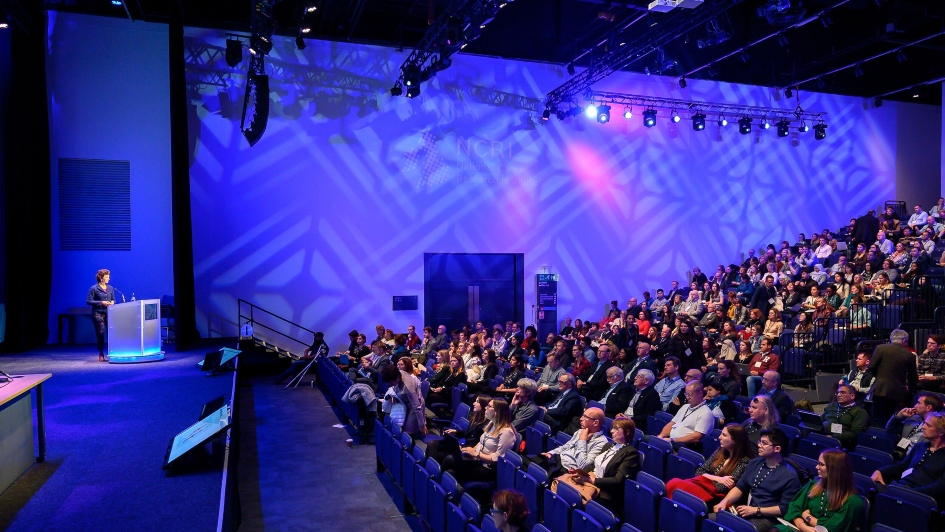
Image: Professor Rebecca Fitzgerald speaking at NCRI 2019. Credit: Simon Callaghan Photography.
Part of improving cancer diagnosis, and diagnosing people on time, is ensuring that people are aware of when they should be making contact with their GP and which symptoms are important to look out for.
It can be easy to think of cancer as a linear progress where one cancer cell becomes many and marches through a series of predefined steps until we see a patient present with a tumour – but the reality is much more complicated than that. Rather than a straight line, it’s a complex, branched tree. Each patient and each cancer is different.
Lots of researchers at The Institute of Cancer Research, London, are focusing on ways to split cancer patients up into meaningful groups within each cancer type so we can make treatment more targeted and personalised.
For example, recent research from Professor Johann de Bono, Regius Professor at The Institute of Cancer Research (ICR), found that prostate cancer patients with faults in genes associated with DNA repair could benefit from a new type of “search and destroy” therapy.
How do you screen for cancer in a way that accounts for all of its complexities? What are the common denominators that you can look for across all or most patients?
The National Cancer Research Institute (NCRI) Cancer Conference is the UK's largest meeting of cancer researchers and doctors. In 2019, the conference is being held in Glasgow from 3-5 November and, as always, the ICR is attending.
Find out more
Patients put up with their symptoms
Professor Rebecca Fitzgerald, from the MRC Cancer Unit, Cambridge, spoke at the 2019 National Cancer Research Institute (NCRI) cancer conference on her area of expertise – oesophageal cancer, where there are a number of challenges when it comes to screening and prevention.
Many people will put up with what they perceive to be ‘mild’ symptoms of the cancer – heartburn, pain on swallowing – for a long time before they go to see their GP, especially if their symptoms can be remedied with over-the-counter medications.
Even patients who do present to the GP will often go home with some antacids and suffer for a lot longer until a cancer screening is on the table.
Professor Fitzgerald shared an anecdote of a patient who was experiencing pain while swallowing, which worsened until soon he had to purée his food in order to eat comfortably. Unfortunately, when he did present to the GP, his cancer was quite advanced, because he had dismissed his symptoms for so long.
An easy pill to swallow
In order to diagnose oesophageal cancer, a patient needs to undergo an invasive endoscopy and a biopsy. By the time this procedure is carried out, the cancer is often at an advanced stage and treatment options can be limited – less than half of patients are diagnosed in time to have a proper intervention.
When treatment is available, it can be radical – including removal of the entire oesophagus.
But a new screening tool developed by Professor Rebecca Fitzgerald, called the cytosponge, is transforming the way we screen for and detect oesophageal cancers.
Patients who have had persistent indigestion can develop a condition called Barrett’s oesophagus, and will sometimes go on to develop cancer of the food pipe as a result.
Barrett’s oesophagus results from persistent heartburn or acid reflux and, until the development of the cytosponge, patients presenting in this way would have been referred for endoscopy to have a biopsy taken.
With the cytosponge, patients swallow a small capsule-like device which is attached to a string. The capsule contains a densely compacted sponge which expands in the stomach and has a rough texture.
As it is pulled back up through the oesophagus and patient’s mouth, it collects cells from every part of the stomach, food pipe and mouth.
Improving patient experience
When Prime Minister Boris Johnson saw the device last week in a visit to Professor Fitzgerald’s lab, he called it a chimney sweep – a fitting metaphor.
Patients tolerate the procedure very well, it can be carried out by a nurse at a GP practice, and the samples generated from the sponge capture the whole length of the system.
Trial data for the cytosponge will be published early next year but preliminary results are really promising. Some 96.5% of patients swallow the cytosponge successfully, and patients report that they prefer the cytosponge to an unsedated endoscopy.
The cytosponge will potentially not only improve patient experience, but could also significantly reduce costs, since it can be administered in a primary care setting.
This device marks a really exciting change in the way we think about cancer screening and prevention – putting patients at the heart of the tools we develop and catching the disease while there is time to intervene with appropriate treatments.
comments powered by